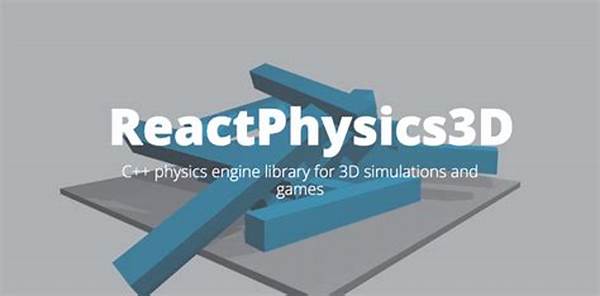Hey there, fellow tech enthusiasts! Today, we’re diving into an exciting topic that’s buzzing in the world of gaming, CGI, and even scientific research. Yes, you guessed it right— we’re talking about physics-based simulation engines. These fascinating tools are the unsung heroes behind realistic animations, lifelike video game environments, and various scientific experiments. Whether you are an aspiring game designer or a curious mind, understanding these engines can add a whole new dynamic to your creative tool kit.
Read Now : Dynamic Sequence Generation Algorithms
What are Physics-Based Simulation Engines?
Alright, let’s get down to the nitty-gritty. Physics-based simulation engines are essentially software frameworks designed to replicate real-world physics within a virtual environment. Now, why would you want to do that? Well, let’s face it—nobody wants a game where objects behave like they’re level 10 users of a levitation spell! These engines are crucial for making animations and simulations look and feel real. They compute everything from gravity and collision detection to fluid dynamics and kinetics. So, every time you watch an epic explosion in a game or observe a realistic wave in a CGI film, there’s a physics-based simulation engine working tirelessly behind the scenes to make it look just right. They’re not just for entertainment either. In scientific research, these engines can simulate complex systems like weather patterns or molecular interactions, providing insights that are otherwise impossible to obtain without extensive real-world testing.
The Importance of Physics-Based Simulation Engines
1. Realism in Gaming: Physics-based simulation engines transform the gaming experience by ensuring that interactions and motions follow the laws of physics, enhancing immersion and realism.
2. Animation Precision: Animators rely on these engines to create lifelike movements and interactions in film and television, elevating the quality and believability of CGI work.
3. Scientific Exploration: In the scientific realm, physics-based simulation engines enable researchers to conduct virtual experiments that would be costly or impractical in the real world.
4. Training Tools: These engines are invaluable for creating realistic training simulations in industries like aviation, medicine, and military, providing safe environments to build skills.
5. Design and Engineering: Engineers and architects use physics-based simulation engines to stress-test products and structures under various conditions before building, saving time and resources.
How Do Physics-Based Simulation Engines Work?
Okay, so how do these digital wizards actually work? When you break it down, physics-based simulation engines use mathematical models to replicate the laws of physics in a digital space. These engines deploy various algorithms to make objects in a simulation obey gravity, understand collision courses, and even simulate fluid dynamics. Imagine dropping a virtual ball from a height in a simulation; the engine calculates how fast it should fall, how it will bounce, and what trajectory it will follow. All these calculations happen in real-time and are made possible by the engine’s use of complex equations and physics principles. Whether you’re running a simple animation or a complicated scientific simulation, these engines ensure that the virtual world behaves as closely as possible to the real one.
Key Benefits of Physics-Based Simulation Engines
1. Enhanced Authenticity: By simulating real-world physics, these engines add authenticity to digital environments, making interactions more believable.
2. Cost Efficiency: They allow for the testing of scenarios that would be expensive to replicate in reality, providing economical and scalable solutions.
3. Safety: In training and educational environments, physics-based simulation engines provide a risk-free space to practice and learn.
4. Adaptability: These engines are versatile and adaptive, catering to various disciplines from gaming to scientific research, and supporting diverse needs.
Read Now : Comprehensive Rpg Maker Walkthrough
5. Instant Feedback: They offer immediate visual feedback, allowing creators to make real-time adjustments and instantly see the results of changes.
6. Predictive Analysis: By simulating potential outcomes, these engines help in forecasting scenarios, such as architectural stress tests or weather models.
7. Creativity Unleashed: The freedom to simulate complex interactions opens up limitless creative possibilities for designers and innovators.
8. Cross-Disciplinary Integration: Physics-based simulation engines can be integrated across multiple fields, fostering collaboration and innovation.
9. Resource Conservation: They reduce the need for physical resources, supporting sustainability by lowering the material and energy demands of prototyping and testing.
10. Precision: These engines offer a high degree of accuracy in simulations, essential for critical applications in research and engineering.
The Future of Physics-Based Simulation Engines
The future looks incredibly promising for physics-based simulation engines. As technology advances, these engines are only getting more powerful, precise, and accessible. Imagine a world where even the smallest indie game developers can access the same high-quality simulation tools as industry giants. The gap between reality and simulation is closing fast, thanks to advancements in processing power, AI integration, and graphic realism. As we move forward, new applications will undoubtedly emerge across sectors like healthcare, architecture, and aerospace, further cementing their importance. Plus, with the growth of virtual reality (VR) and augmented reality (AR), physics-based simulation engines are set to play a crucial role in creating immersive experiences that are almost indistinguishable from the real world. It’s an exciting field that promises to revolutionize how we interact with both virtual and physical spaces.
Physics-Based Simulation Engines in Everyday Life
You may not realize it, but physics-based simulation engines touch many aspects of our everyday lives. From the video games we play to the weather forecasts we rely on, these engines work behind the scenes to provide realistic outcomes and predictions. In entertainment, they ensure that movies and games deliver consistently thrilling experiences with believable animations. In education, they offer interactive ways to explore complex scientific concepts, making learning both fun and effective. When it comes to industries, they are used for virtual prototyping, allowing engineers to experiment with designs in a cost-effective and resource-efficient way. These engines have even found a place in our phones, optimizing processes and enhancing functionalities that modern gadgets offer. So, the next time you experience something seamless and realistic in a digital environment, give a nod to the trusty physics-based simulation engine working its magic!
Summary of Physics-Based Simulation Engines
To wrap up, physics-based simulation engines are the backbone of creating realistic virtual environments across numerous applications. Whether it’s adding authenticity to video games or enabling sophisticated scientific simulations, these engines are revolutionizing the way we experience digital and physical worlds alike. Their ability to simulate real-world physics provides invaluable benefits, including cost savings, enhanced safety, and limitless creative possibilities. As technology continues to advance, the scope and capability of these engines will further expand, opening up new frontiers in innovation and discovery. They play a pivotal role not just in gaming and entertainment but also in education, engineering, and various scientific disciplines. So, whether you’re a gamer, a scientist, or just someone intrigued by technology, it’s worth keeping an eye on the evolving landscape of physics-based simulation engines.




